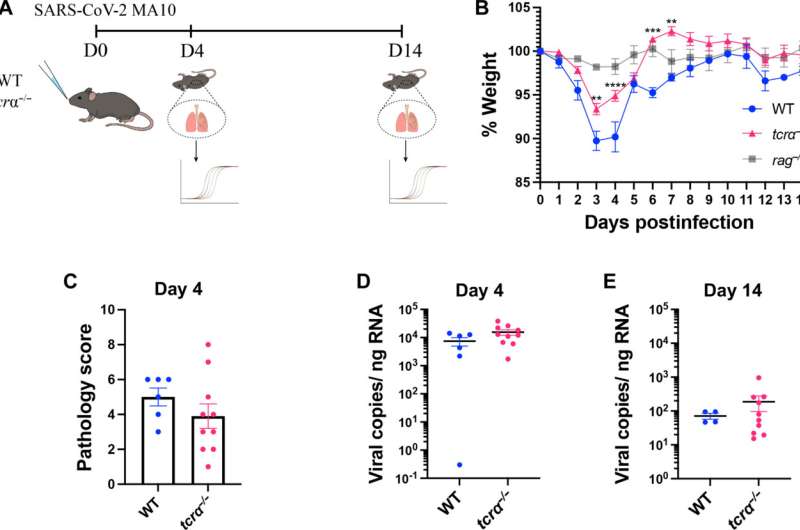This article has been reviewed according to Science X's editorial process and policies. Editors have highlighted the following attributes while ensuring the content's credibility:
fact-checked
peer-reviewed publication
trusted source
proofread
Research reveals mice without immune cells show no SARS-CoV-2 symptoms

When mice lacking key adaptive immune cells were infected with SARS-CoV-2 virus, even though they are not able to clear the virus, they developed no symptoms, revealing that the body's own inflammatory immune response to fight the infection was causing the pathology, according to a new study.
While the inflammatory response from adaptive immune cells—such as B and T lymphocytes—clears the body of the virus, it also causes the characteristic symptoms of COVID-19.
The results of the study "Adaptive Immune Cells are Necessary for SARS-CoV-2-induced Pathology," which was published Jan. 3 in Science Advances, also point toward a potential treatment against the virus' effects.
"Unlike the main other respiratory viruses that circulate, without the adaptive immune response, on its own, SARS-CoV-2 doesn't seem to cause the damage that leads to significant pathology," said Avery August, professor of immunology in the College of Veterinary Medicine (CVM) and deputy provost. August and Hector Aguilar-Carreño, professor of virology, also in CVM, are co-corresponding authors of the study.
"It means that we can explore therapeutics that modulate the immune response, so that we can dampen those parts that are causing inflammation while leaving those parts alone that are important for clearing the virus," August said.
In the study, the researchers used a strain of SARS-CoV-2 that was adapted to infect mice, as the strains that infect humans don't cross over well to mice. The approach allowed the study's authors to directly infect a variety of engineered lab mice that lacked elements of their immune systems, including mice that don't produce B or T cells, which would otherwise recognize and respond to pathogens.
In a normal course of infection, mice begin losing weight around day three or four, and continue to do so until about day seven, when many mice are often euthanized after too much weight loss, but some do survive, depending on their viral loads. The scientists monitored the amount of infection in the lungs, partly to make sure they were indeed infected.
They also examined the lung tissues for indications of a robust immune response, such as the presence B and T cells and other inflammatory immune cells, and for cytokines—signaling proteins that direct immune cells towards an infection site and are associated with inflammation.
The team's initial hypothesis was that mice without B and T cells would experience severe symptoms and not be able to handle being infected with SARS-Cov-2. For example, when the same engineered mice were infected with a mouse-adapted flu, they had to be euthanized due to severe weight loss without immune cells to protect them.
"We were very surprised when it turned out that [the mice infected with SARS-CoV-2] didn't lose weight, they didn't have any symptoms or pathology," August said. At the same time, regular lab mice (called wild-type mice) used as controls displayed the hallmark SARS-CoV-2 symptoms, including immune cells collecting in the lungs and an inflammatory response to clear out the virus.
When the infections in the genetically engineered mice were extended out 30 days, they still had no weight loss, behavior changes or inflammation in their tissues.
August, Aguilar-Carreño and colleagues also tried an intermediate approach by infecting mice that had B cells but lacked a majority of their T cells, and these were also less affected by the SARS-CoV-2 strain.
"Without B or T cells, the virus can replicate, but it doesn't cause any damage, because the harm is being caused specifically by the adaptive immune system," August said.
Additionally, the researchers used genetically modified mice that specifically lacked a protein important for T-cell activation, and those mice were also somewhat protected from COVID-19 symptoms.
More information: Brian Imbiakha et al, Adaptive immune cells are necessary for SARS-CoV-2–induced pathology, Science Advances (2024). DOI: 10.1126/sciadv.adg5461



















